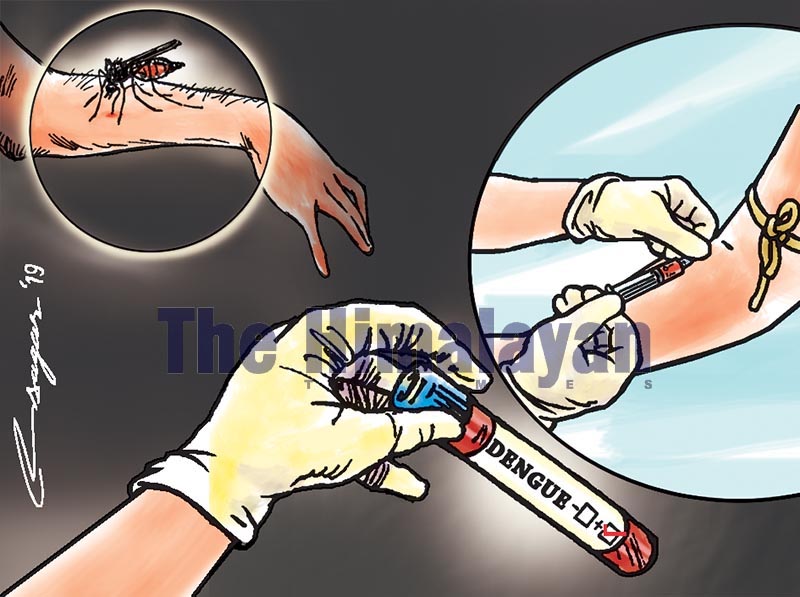Dengue: Prepare for the next outbreak
Our previous research shows that there is a dengue outbreak every three years, and the 2019 outbreak is as per our prediction. So there is going to be a major dengue outbreak in 2022
Dengue is a major public health problem in the tropical and sub-tropical regions, including Nepal. It is a mosquito-transmitted disease, characterised by fever, headache, muscle, joint pains, rash, nausea and vomiting.
The first case of the dengue virus in Nepal was observed in 2004. Since then major outbreaks have taken place in 2010, 2013 and 2016. This year, more than 5,000 cases of infection along with several casualties have already been reported from different districts. Our previous research and publications show that there is a dengue outbreak every three years, and the 2019 outbreak is as per our prediction.
According to this prediction, there is again going to be a major dengue outbreak in 2022. The major epidemics to date have demonstrated their capacity to be explosive and challenging to currently available disease control measures.
Dengue has four serologically distinguishable strains, DEN-1, DEN2, DEN-3 and DEN-4, which are capable of causing dengue fever (DF). Although infection with one serotype confers lifelong protection against that serotype, it does not necessarily protect one against a secondary infection with a heterologous serotype. This is because of the formation of memory cells of the previously attacked serotype of the virus. It is interesting to note that these serotypes also change from year to year with the emergence and re-emergence in different time periods. The first case of dengue infection that started with serotype 1, 2 and 3 in 2006, continued with serotype 1 in 2010, serotype 2 in 2013 and 1 in 2016.
The female Aedesaegypti mosquito, the transmitter, commonly lays eggs on the inner walls of artificial containers that are filled with water. The adult mosquito then can fly from one area to another. So our control strategies should be focussed on removing mosquito dwelling places, such as old tyres, cans or flower pots that collect rain. The dengue virus is spread through a human-to-mosquito-to-human cycle. Humans are the main amplifying host of the virus. This means that people, rather than mosquitoes, rapidly move the virus within and between communities. So there is a high chance of transmission in overly crowded regions like Kathmandu, where the rainfall and climatic factors are also favourable. A single mosquito can infect many people at a time in such conditions.
Currently, there are no effective vaccines or antiviral drugs against the virus. This problem thus needs to be addressed as a matter of urgency as failure to develop effective control strategies will inevitably increase the number of infected humans and expansion of infected territories regardless of the climate and altitudinal factors. This year’s outbreak saw its territory expand to more than 44 districts. Studies over the past few years have also shown that the months of infection have also expanded the timeframe from July to October and even December at times. This means that we still have more months to struggle with.
Dengue can be diagnosed by isolating the virus, by serological tests, or by molecular methods. The dengue viruses RNA and NS1 are detectable during the first week of illness. Anti-DENV IgM is detectable starting approximately five days after the onset of the illness. Diagnosis of acute (on-going) or recent dengue infection can be established by testing serum samples during the first five days of the symptoms or early convalescent phase (more than five days of symptoms). The correct diagnosis of DENV in the preliminary stages is very important to prevent the patients from more severe complications. Rapid diagnostic kits should be made available to all infected areas so that early diagnosis can be made. Cost effective diagnosis or cost-free treatment should be made available to the infected people.
“Diseases and natural calamities do not differentiate between rich and poor.” Keeping this in mind, we must prepare to protect ourselves from the attack of diseases. There should be combined efforts of the government bodies down to the local level to implement the control strategies. There is a pressing need to undertake effective vector surveillance studies, backed by well-equipped diagnostic virology laboratories. The infection is nearly out of control this year, and in this condition, the government can utilise the graduates and health professionals to create awareness about the control methods.
Capacity-building has been neglected at all levels of dengue prevention and control. Effective training must be scaled up to the national level. Social scientists and communication specialists, public health entomologists, vector control personnel, epidemiologists, diagnostic laboratory staff, and healthcare personnel play essential roles and need to work together. Prevention is always better than cure.
As there is no specific medicine for dengue infection, personal protection strategies are the best way to stay safe. Use of mosquito repellents, staying indoors in the evening, wearing long-sleeved shirts and long pants and timely visit to the hospital and avoiding unwise use of antibiotics are the ways to protect oneself. Furthermore, community-based control strategies along with the participation of the media can play a pivotal role in creating awareness in the people.
Lamsal is a researcher in virology and part time faculty at TU






